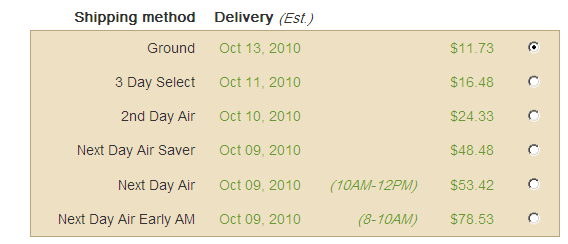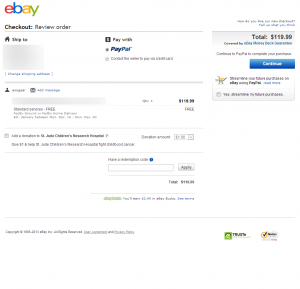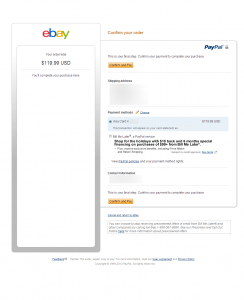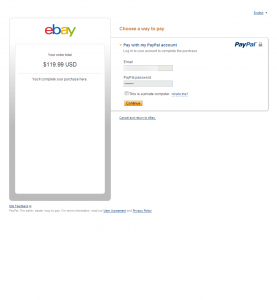Archive for the ‘General’ Category
How not to decline a transaction – ebay and paypal 2013
I was amazed today trying to checkout on ebay that ebay and Paypal still haven’t figured out how the transaction flow is supposed to work. If a paypal transaction declines when checking out on ebay, rather than giving an error like reason would suggest, they just dump you on a login page. Yes folks, a login page. I’m more or less laughing at this instead of being upset because it’s so absurd that I can hardly believe it myself.
I repeated the process 3 times just to rule out user error and took some screen shots for entertainment.
The ebay checkout page:
The payment page:
The decline page:
I was only able to figure out this was a decline when I logged in again, and then finally there was a cryptic message about the card being declined. After trying a second card and inevitably going through a loop of declines I eventually gave up on trying to make payment.
Anyway, this is a good example of what not to imitate. It should be pretty embarrassing for both ebay and Paypal considering they are considered founders in ecommerce and online payments. Happy holiday!
The un-usability of online video
Just about every news website and blog uses online video as a means of communicating with their audience. Online video started gaining popularity several years ago with the creation of youtube and other video sharing services. Youtube gained immediate and nearly unprecedented popularity. Media companies looked at this inspiring boost in traffic and had to figure out a way to monetize online video.
Putting history aside, online video is often used improperly. Companies are hanging on some antiquated TV theory that people want everything delivered in video and not in text. I’ve gotten to the point where I won’t even watch a video article online.
The biggest problem people make, is using an unextraordinary video as a destination rather than additional media or commentary that accompanies an article or other piece of information. I can’t even tell you how annoying it is to click on a news article and have it be a video instead of text. What’s even more annoying is that whole “monetize” concept. I not only cannot read the article I wanted to read, but I have to wait 30 second to see a video which i didn’t want in the first place. Using video just for the purpose of using video is just crazy. I don’t need to see some newscaster or blogger reading something to me that would have takes 2 minutes myself and would have been more clear and scan-able. I will say that online retailers have much better grasped the concept of appropriate video usage, as they often supplement their products with video demos or other informative casts.
In all, if the video is the point of interest, such as a show (in whole or part), a movie, or something that cannot be better represented in text then it’s probably appropriate. If the video is simply a person reading an article, or newscast, or anything that could more easily be explained in text, use text! The same concepts can be applied to slide-shows, flash, and just about any other dynamic content we find on the internet. Don’t use media as a destination just for the sake of using it.
The one caveat to this argument is mobile content. Since it’s often difficult to read lengthy content on a phone, a video may be more than appropriate. However, this doesn’t mean that video should be the only medium that the content is available in. At the very least, put an entire text version with any diagrams or pictures if appropriate below the video so the rest of us on normal computers can “read” it.
The importance of hardware consistency
If you look at any of the posts I’ve done regarding server or computer setups, you’ll find some similarities in the way I set things up. After enough testing myself and reviewing other people’s experience I like to stick with certain brands and specific models of hardware when setting things up. For example, I almost always use Tyan or Supermicro motherboards for servers, Dell Optiplex computers for desktops and workstations, CentOS for server operating systems, Areca hard drive controllers, the same brand and model hard drives when possible, etc..
A few months ago we had a major server crash, and the importance of using the same hardware came blatantly apparent. We lost our primary web server for reasons unknown at the time, and after some panicking and troubleshooting, we found that the server’s hard drive controller was blown. This is the first controller of its type that I’ve ever completely lost, and luckily it’s the same controller that we use in almost every server we own, and even some workstations. Rather than having to completely rebuild the server from the ground up, or overnight an expensive controller for several hundred dollars in shipping fees alone, we took an identical controller out of a backup server, and had the machine back up in a much shorter amount of time, about 2 hours, without any re-configuring. Normally we have backup hardware but $1500 hard drive controller cards aren’t something we keep a lot of in stock.
Typically, when you start doing everything yourself, or run a limited or no-IT company, which many entrepreneurs and boot-strapping business and non profit owners do, you’ll want to stick to the same hardware and same software when you can. Running IT like this can greatly reduce setup and administration costs and greatly increase the speed that things get fixed when they go down. It also allows you to keep broken hardware and use it effectively for spare parts. And finally allows you to stock backup supplies like hard drives, power supplies and fans and not worry about them going to waste. If your IT, or yourself if you are the “IT department”, have computers and servers from 10 brands, all with different software and different operating systems, it’s time consuming to just to figure out what a problem is and more time consuming figuring out how fix it.
Computer accessories that are often interchangeable:
Case and CPU fans
Power supplies
Computer cases
Hard drives
CPU’s
RAM
CD / DVD and floppy drives
Power cords
Video cables
Operating system installation disks
Because computers become obsolete and some die more quickly than others it’s probably not possible or a good idea to always replace dead hardware with the same hardware. However, when your Dell GX280 goes down, it’s likely that the GX750 is going to be more similar than a HP or Sony computer, whatever the model. This allows you to progressively upgrade computers and equipment and continue a logical administration pattern.
The caveat to upgrading and administering IT like this is that it inherently prevents you from getting more reliable or more appropriate equipment. If you convince yourself that some computer model or brand is the best, you prevent yourself from even looking at other options when it comes time to purchase new, or upgrade existing equipment. Make sure you research the equipment that you are interested in purchasing before you do, especially if you are just starting out. IT firms can be a good source for learning what is good and reliable equipment, but they may also have their own motives in mind, so it’s important to do your own research when you go to purchase equipment as well. Also, don’t just read reviews but try to connect with other businesses that are similarly setup. Finally, don’t take consumer reviews the same as a business owner or IT review. Business and consumer usage often differ greatly, so as a business owner, you should be more focused on long term reliability in performance and failure rates, while consumers are much more often concerned with aesthetics or some arbitrary performance level.
Another caveat to all similar equipment is the potential for synchronized failures. We experienced this will some hard drives that were all purchased at the same time and were all the same model and had nearly sequential serial numbers. Non-coincidentally, they all started failing at the same time, literally within days of each-other, in separate computers, all 2 years before the warranty was up, which leads us to conclude that they had some defective part in them causing them to fail at the same time. This can end in a true IT disaster as most disaster preparedness plans don’t account for synchronized failure like this. Let’s say a very important database server(s) were built with identical hard drives for redundancy. One of the primary reasons for multiple drives was to prevent data loss if one or two or maybe even three drives failed. It’s unlikely that any plan was in place for all the drives failing. Assuming you have external backups, it can still take a long time to restore the system even if you have a solid disaster recovery plan. There;s not really any sure fire way to circumvent this sort of failures, but it’s something to keep in mind, if you start getting a lot of similar premature hardware failures.
So if you are starting out, or next time you go to purchase equipment, make a solid plan on how you will replace and upgrade equipment in the future and maximize the benefits of hardware consistency. Unless you choose the wrong computers from the start, this will save most businesses a lot of time and money in the long run.
5 tips for limited or no-IT companies
- Buy the same brand and line of hardware when possible (Assuming it’s solid and reliable).
- Buy the largest size desktop computers possible. Ultra compact computers break much more often and are difficult to impossible to replace components in.
- Always buy computers that include a full operating system installation disks. The branded system recovery disks are worthless. Find a new brand if you can’t get actual Windows or actual operating system installation disks!
- Used and refurbished computers are great but know that they will fail more often than new computers. The cost savings is still usually worth the risk of failures.
- Unless you run software requiring very high performance hardware, don’t think you must have the latest and greatest equipment.
Call your congress-person, oppose the American Firewall
In case you haven’t been paying attention to the US political landscape, there is currently a bill in progress dubbed the great American firewall. It is a thoughtless overreaching nightmare’ish bill that claims to be for preventing copyright infringement.
Please read up and understand the implications of what this bill will do. There has never been a more 1984esque bill to be taken up by both houses of congress. It is absolutely ridiculous that our country would go this far just to help the massive media corporations under the veil that they are doing it for the good of the people. While supportable in concept, this is one of those “the road to hell was paved with good intentions” bills in what it will actually do.
Please contact your congress person and oppose this bill.
Who are you sharing your customer data with?
 I see new products and services from large retailers and large online companies all the time. Sometimes these services can be extremely helpful to the ecommerce website owners. Services such as product reviews, facebook or social media widgets, customer feedback, additional payment methods, etc., can help small websites look more authoritative and help build visitor trust. It’s trust that gets your customers to purchase from you, just as much as the prices you sell your products at, right?
I see new products and services from large retailers and large online companies all the time. Sometimes these services can be extremely helpful to the ecommerce website owners. Services such as product reviews, facebook or social media widgets, customer feedback, additional payment methods, etc., can help small websites look more authoritative and help build visitor trust. It’s trust that gets your customers to purchase from you, just as much as the prices you sell your products at, right?
The internet and the companies that we routinely see operating on it have become such common names that most of us hardly stop to consider how these companies that we trust make money, and what they do with the information that we give them. When we’re talking about information on a personal level, the potential loses are fairly low if some company decides to use or share our data with others. Facebook, Google, MySpace, Linkedin, Twitter, Amazon, Walmart, Target, and just about any other major player on the internet uses your personal information in some manner. Most of the time, the worst thing that could come from misuse of your information is increased spam email or targeted advertising directed to get you to buy some product. When we look at the same information privacy scenario from a business perspective, the repercussions of sharing your information can be severe.
Small business owners need to be vigilant in who they share their data with!
I’ve personally talked to more than handful of website owners who watched Amazon become their biggest competitor after they launched a successful Amazon.com business. I’ve heard of elaborate buying schemes with lawyers, accountants, and capital firms, even involving publicly traded companies, just to get a crack at some successful company’s marketing and analytical data. It’s sometimes hard to see the value in data but it’s there. Facebook was valued at nearly $50B ($50,000,000,000) just a few months ago, when as a company they make less than $1B per year in revenue. Just think about that…
Unlike personal information that sellers would use to sell you products, your business’s information can be used to compete against you. It can be used to out compete you. It can be used to steal your customer and lead sources. It can be used to figure out how your SEO campaign gets links. How your PR company promotes your business. Your data may only be giving you a snapshot of how you got your customers. It will give another company a playbook on how to steal your customers.
Now, just because you currently trust one of these companies and use a service that collects data about the way your website works and the way your customers work, doesn’t mean that you are going to have a MyProducts.SomeOtherCompany.com website popping up in a week. What it means is that before you add some global script to your site like Google analytics, or Shopping.com tracking, or an affiliate tracking script, or join a product comparison site, or anything else, you should be damn sure you understand what that company is going to do with your data.
I’ve been running ecommerce websites for nearly 10 years, and something that I can tell you with 100% certainty is that the knowledge, the experience, the information and data you gain in creating a successful online business, is as important as the business itself. It’s one thing to trust a company with your personal information. It’s entirely different to trust them with your business information, especially if there’s any chance of them competing against you.
Small businesses need to be careful with whom they trust with their customer information!
A few weeks ago, there was a major breach at a massive email marketing company. Citigroup, JPMorgan Chase, U.S. Bank, Barclays Bank, Best Buy, Hilton WorldWide, Marriott International, Disney Destinations and The College Board were among the clients that lost their customer information in the data breach. While there wasn’t any loss of credit card or other highly sensitive information, there was a loss of names and email addresses. This creates huge avenues for phishing fraud, and is a huge blow to the integrity of these corporations.
The difference between these giants and the rest of us, is that they can easily withstand a data breach. They have the money and PR budget to survive and in many cases these companies are so big that their customers don’t even have a reasonable alternative to switch to. Unfortunately this is rarely the case for small businesses. A good percentage of businesses that suffer a data breach from themselves or due to a 3rd party go out of business, some are forced to sell, all suffer nearly-irreparable damages. The bottom line is that most businesses cannot afford a major data loss neither in names and email addresses nor in a more severe case like credit card or banking information.
In cases like Epsilon it’s hard to fault the companies whom had lost data. If they trusted Epsilon with their information, there’s a good chance that Epsilon was pretty secure. Business owners should nonetheless be diligent in any partner’s security practices and certifications. This would include PCI and other industry security standards and would include making sure the company you are giving data to has a solid and logical data security policy. It also should be clear if they share the data you provide with 3rd parties, for security sake and for the above reason.
Data, while intangible, may be the most important asset of your company without you even knowing it. Take a step back and make sure that you trust whomever you share it with, and make sure that you aren’t providing a new competitor with an avenue to compete or to put you out of business.
Payment method and credit card logo API
I just finished a simple credit card logo API which is outlined on my other blog.
This offers an easy method of adding credit card logos to an ecommerce website. We designed some very clean icons for each logo. The API supports 2 sizes currently, fully dynamic sizing and margins are planned for the next update. It also supports specifying background colors.
Here’s a few examples of logos generated using the API.
Using: https://www.merchantequip.com/image/?bgcolor=000&logos=p|g|bml&height=75
Using: https://www.merchantequip.com/image/?bgcolor=fff&logos=v|m|a|d|jcb|dc&height=75
Using: https://www.merchantequip.com/image/?bgcolor=fff&logos=v|m|a|d|jcb|dc&height=35
The order and the exact logos can be specified through the image url string. The logos currently come in 2 sizes 32px and 64px, but as stated, fully dynamic sizing will be available shortly. Logos through the API are all delivered securely to prevent SSL related errors. We also made a simple credit card logo generator for those who don’t want to mess with an API.
Here’s all available logos:
What is a trust seal actually worth?
 I was asked the question this week of what trust seals I would recommend a website use? Trust seals would include services like Mcafee, Truste, the BBB, Verisign SSL, etc. Putting aside any potential real benefits in security, I think that these seals can help a business increase their conversion rate. However, I think the statistics touted by the seal providers themselves are greatly exaggerated, even to the point of them being statistically impossible. I’ve seen statistics like “over 70% increase in conversions”. While this may be theoretically possible, it’s just not plausible that the site seal somehow convinced double or more the amount of visitors to make a purchase, unless there were serious problems with the site before the seal was installed, or there wasn’t enough data for statistical significance.
I was asked the question this week of what trust seals I would recommend a website use? Trust seals would include services like Mcafee, Truste, the BBB, Verisign SSL, etc. Putting aside any potential real benefits in security, I think that these seals can help a business increase their conversion rate. However, I think the statistics touted by the seal providers themselves are greatly exaggerated, even to the point of them being statistically impossible. I’ve seen statistics like “over 70% increase in conversions”. While this may be theoretically possible, it’s just not plausible that the site seal somehow convinced double or more the amount of visitors to make a purchase, unless there were serious problems with the site before the seal was installed, or there wasn’t enough data for statistical significance.
So, the real question is, what makes these seals justifiable?
Realistically, if a site seal provides any increase in conversions, there is a point where the benefit surpasses the cost to obtain a site seal. But, where is that point?
My typical answer is that for a new website they will not provide a positive ROI until the business has a substantial amount of sales. Basically, don’t get one until you are already well established. Substantial is a very ambiguous answer, let’s look at what substantial sales actually mean.
Let’s say a site can benefit by a 5% increase in raw conversion by installing a trust seal, far below the 75% that some claim, but still high as far as I’m concerned. Let’s also say they are using a seal that costs $1000 per year, and are currently operating with a 20% profit margin.
Plugging this into an equation to calculate the sales required for a positive ROI:
(profit margin)(sales + increase in sales) = (cost of seal)
.20(1x + .05x) = $1000
.20(1.05x) = $1000
1.05x = $1000/.2
x = $1000/.2/1.05
Sales = $4761.90
This business would need an additional $4761.90 in sales in the next year, or $396.86 per month, to get a positive ROI on their site seal investment. If the business operates on a very tight profit margin (say 5%-10%), which is increasingly common with online businesses, this number goes up quickly.
As far as sales go, still assuming the 5% increase in sales, this business would need to currently be doing this much to break even in exactly 1 year:
(increase in sales)(required sales) = (monthly cost of seal)
.05x = $396.86
x = $396.86/.05
Required sales = $7937.80
 So, you can see how much in current sales this business needs to break even on their purchase of the trust seal: $7,937.80 per month, or $95,253.36 per year.
So, you can see how much in current sales this business needs to break even on their purchase of the trust seal: $7,937.80 per month, or $95,253.36 per year.
This isn’t an astronomical number for an established website, however for a brand new website it’s probably a lot. Additionally, it’s not uncommon for a business to purchase multiple site seals. I can say that as the number of seals goes up, the conversion rate per seal goes down, making more sales required for the seals to generate a positive ROI.
If a business has 3 seals installed all for $1000, and the end conversion increase for each seal is 3.3% (we’ll assume an extremely generous 10% total for all 3 seals). This would require an existing monthly sales volume of $36,291.06 ($435,492.72 per year) just to break even on the trust seals.
These are all just made up numbers, but they’re in the realm of possibility as far as costs, increases, and profit goes.
The sneaky-tricky stuff!
The tricky stuff: There are many variables in measuring an increase in sales. It’s almost impossible to attribute an increase 100% to the installed site seal, even if a single variable A-B test is performed. There are factors outside the checkout process that have a lot to do in determining the type of visitors that are coming to a site, and the sales of that site. Even so, a single-variable A-B test would be the most appropriate way to test the conversion rate increase in adding a site seal.
The sneaky stuff: One caveat is that if a seal instantly increases conversions, you could be losing money by performing the A-B test at all. This creates psychological motivation not to test, and is one of the strongest retention methods of site seals in general. The majority of website owners have bought into the seal before they even install it and no test is ever performed.
As site owners we almost always get grossly skewed statistics on the effectiveness of site seals, especially if those statistics are coming from the person trying to sell it. I can honest tell you that you should not expect a 70% increase in conversions by installing a site seal, and I don’t think I would expect a 10% in most cases.
If you are going to install a site seal, I strongly recommend performing an A-B test for a few months, or at least until some statistical significance is reached, to see if it will be worth spending the money on the seal again. Also make sure you are getting outside opinions as to the seal’s effectiveness (although this may be impossible). It is extremely difficult to find objective and statistically accurate comparisons of site seals or any single site seal for that matter. There is simply so much hype as to their effectiveness, there’s no honest information about them anywhere. Proceed with caution…
The site seals I recommend that could possibly work
These are the only site seals that I could possibly recommend looking into. There are probably a million out there, but there are very few that anyone cares or knows about. Most seals just add clutter to a page, potentially decreasing the sales potential the page would otherwise have.
Verisign SSL
Mcafee
Truste
BBB
and finally, any EV SSL (I recommend Comodo EV SSL)
Best shipping practices for ecommerce websites
I think that shipping is one of the most difficult aspects of running an ecommerce site. In my experience and observations of other sites, shipping costs and delivery time-frames are the biggest customer complaint that online retailers receive, a recent study confirms shipping to be one of the most important thing to shoppers. Even if the shipping is free, customers often have obscene expectations on how fast their order will reach them. If it’s not free, there are always complaints about the cost even when the merchant directly passes down fees with no markup.
This is my guide on presenting, charging, and handling shipping services and fees for small online retailers.
- Have a shipping policy section on your website.
- Show shipping options, prices, and delivery time-frames.
- Be very cautious about offering free shipping.
- Don’t use USPS.
- Ship Now!
- Keep your customer informed.
Have a shipping policy section on your website.
 When your customers know what to expect, they are less likely to be upset when you do exactly what you said you would. No matter what your company’s policies are on shipping, even if they are simply rotten, make sure that they are clearly posted on your site. Make sure that you do better than any policy on your site, shipping or otherwise. A shipping policy or refund policy should be a fallback point, not a guideline. If you say we ship within 48 hours, ship today.
When your customers know what to expect, they are less likely to be upset when you do exactly what you said you would. No matter what your company’s policies are on shipping, even if they are simply rotten, make sure that they are clearly posted on your site. Make sure that you do better than any policy on your site, shipping or otherwise. A shipping policy or refund policy should be a fallback point, not a guideline. If you say we ship within 48 hours, ship today.
Show shipping options, prices, and delivery time-frames.
On the shopping cart page, make sure you show available shipping options with their price and the estimated delivery time-frame. This does not mean, make your customer register or fill out their shipping address or fill out anything at all, before you show them shipping options. Ask for their zip code only (Not their zip and state, you can figure this out yourself) if your prices vary based on the delivery location.
I find that the best way to visually present shipping options is a list with a radio button for them to select their desired method. This is better than a drop-down box because it is easier to see and compare all of the options, and doesn’t require any clicking. Make sure to preselect the cheapest or the best value shipping method for them. This way they don’t have to interact at all if that’s what they choose.

If you use UPS or Fedex they offer tools to help you determine the delivery time-frame. Make sure to have your programmer use logic if you ship tomorrow, or need an extra day for packing, or your customer places an order on Sunday, a Holiday, etc. The delivery time-frame should be as accurate as possible. But when in doubt, add an extra day for padding. It’s perfectly fine to deliver early, but is never acceptable to deliver past the date you said you would.
Be very cautious about offering free shipping.
Free shipping is great. It can drive sales and give a company a huge competitive advantage. I’ve experimented on ebay many times with offering the same product at different prices and different shipping prices. Free shipping is a large enough incentive that many people will chose a more expensive overall price, over an item with high shipping costs. Shipping costs make people feel like they are being gouged, so there’s psychological motivation when shipping is very cheap or free.
However, free shipping is not great when you need to cancel it. If you have an established website, canceling free shipping can literally kill the business. Especially in the case of repeat customers, you can lose a lot of business when you revert back to a paid shipping format. This even applies to limited time free shipping promos.
A good alternative to free shipping, is free shipping based on price thresholds. This can also backfire though, as online retailers often make the same profit (not margin) on expensive products as cheap ones. If your products get heavier as they get more expensive, you can end up cannibalizing all profit if you offer free shipping in situations like this. You need to do the math for your products and your shipping fees, but make sure you aren’t destroying your profit by offering this.
In any case, be very careful if you decide to offer free shipping, or threshold free shipping, even as a promotion. The backlash when you retract it, if you can retract it, can be severe, and it just may not work from a shipping cost to profit perspective.
Don’t use USPS.
 USPS can be great for some product types. It is perfect for low ticket products or those that can be crammed into a pre-paid priority box or envelope. It’s also great if your customer has no expectation for the package to get there in the next week, month, ever…
USPS can be great for some product types. It is perfect for low ticket products or those that can be crammed into a pre-paid priority box or envelope. It’s also great if your customer has no expectation for the package to get there in the next week, month, ever…
If you’re like most of us, USPS is nothing but a headache.
To start off with, their package tracking is simply unacceptable. Since about 1998, customers have expected to be able to see their package progress once it is shipped. With USPS this current day, they can possibly see cryptic postdated message after it’s updated at 7 or 8PM in the evening. Did I mention that delivery confirmation, package tracking, and just about any other expected service costs extra.
Next, the package pickup services leaves something to be desired. Unless you’re shipping out a semi trailer of packages every day, you need to have the box at the pickup location or post office very early for it to go out the same day. This is completely unreasonable for most online retailers that ship their own products. To make this work, you almost have to delay all orders from shipping by a day so they can be packaged the next morning.
Third, delivery time-frames are a complete toss up. Here in Texas, I’ve seen packages take 1 day, and 5 days in the same state. There’s no reliable way to predict the delivery time-frame. Your customer asks you when the package will be delivered. Your answer of “sometime in the next 5 days” does not make people happy.
Lastly, when USPS loses a package, which happens all the time, it’s a bureaucratic mess to try and find it or get compensation for it. The time it takes to recover anything often offsets the loss of the product and the cost of sending a new one.
There’s good reason why almost every highly successful online retailer uses UPS or Fedex despite them being more expensive.
Ship Now!
Probably most important of all is just ship the damn package now! Don’t wait for 2 days to package it up, and another day to label it and another day to drop it off. Get it in a box, put a label on it and get it out the door.
If you want to be a remarkable online business, your packages must go out the day you receive the order.
I can’t count how many times I’ve ordered and finally after 5 days, I get an email that my package has been shipping. Seriously, did you have to build the manufacturing plant, required to manufacturer my product or something??? I will not buy from you again if it takes 5 days to ship unless there is some extenuating circumstance and you told me about it immediately.
The quicker you get the package out, the happier your customer will be and you no longer have anything left to perform with the order. Everybody wins when you ship quickly.
Keep your customer informed.
Through every step of the purchasing to shipping to delivery process, you should be keeping your customer informed on the status of their order. This is the one area that you have 100% control of, so there’s no reason not to do this. Send an email letting them know you received the order. Email letting them know it shipped. Email letting them know that you messed up and it’s back-ordered. Email letting them know it was delivered, and follow up in a few weeks to make sure they got it, and it is what they wanted.
This last step is extremely important for 3 reasons. First, it is a proactive approach at solving any problems your customer may be having. It tells them you care enough about their satisfaction that your reaching out to them to make sure everything is excellent. Second, it helps prevent chargebacks by reminding them that they purchased something from you (They will be receiving their statement about right now and they forgot the name of your company. Sorry, it just works this way.). Also, if there’s a problem they know to contact you and not their bank. Last, it gives you an opportunity to make another sale with your new customer. Offering coupons or other incentives is an excellent way to gain a repeat customer and this email is the perfect medium. Too often I see this used with an aggressive marketing tactic to get warranty sign-ups or other high-profit, tasteless services. Don’t forget, this email is still about them so keep it reasonable if you want them to come back.
Concluding thoughts:
No matter how awesome your business is, you will get complaints about shipping. You may not meet some-one’s expectations, you may ship a day later than they were expecting, they think you can miraculously ship or deliver on Sundays, your packages will get lost or destroyed or delivered to the wrong address. As long as you are handling shipping in the best way possible, there’s little more you can do except provide good support to your customers when something does get messed up. If you’re running a site that makes your customers register or fill out a form before getting options, or you ship 5 days after you receive an order, I can almost guarantee your sales will immediately improve once you implement some better shipping practices.
5 things your retail (non-ecommerce) site must have
If you own a small business but don’t actually sell products on your website, listen up. For retail and restaurant websites, these are some of the features that your site MUST contain, but many sites miss some or all of these, or they’re too hard to find to be effective.
Even if your website consists of only a single page, make sure that it has no less than the following, in no particular order.
- Store hours
- Telephone number
- Street address of all locations
- A list of products and brands that you carry
- Specials, sales, and web coupons
1. Store Hours
Make sure that your site clearly lists the standard operating hours and holiday scheduling. If you aren’t operating an ecommerce site, try to put these on every page. If you have multiple locations, make sure to put the hours for every location if they are different.
Don’t make it difficult to find your operating hours. Putting them prominantly in the sidebar or footer of every page is a great way to do this in a clean and elegant manner.
2. Telephone number
Your local, and toll free if you have one, phone number should be clearly listed on every page of the website. If your business provides any sort of continuous support, make sure you put your after hours or other pertinant support numbers on there as well.
3. Street address of all locations
Every location that you operate should be listed on your site. If you only have 1 location, put the street address and a link to a google map on every page. The footer is an excellent place to do this.
If you have a handful of locations, use a dedicated page for all locations, and make sure to include a google map link, and the business hours for each location on the same page.
If you have many locations, a “find nearest location” search function should be accessible from every page. These are best placed in both the header and footer of the site. You can put a quick zip code based lookup in the header of every page to make it extra-easy. Again, on the detail page for each location, make sure to put a maps link, the phone number, and the business hours for that particular location.
4. A list of products and services that you carry
You know a lot about your business, but a new customer probably won’t know specific details just from your name alone. You should always list major brands that you carry, or if you provide services, and anything else a customer might want to know before coming into your store.
“We sell sporting equipment” is not a good description.
“We sell the finest rock climbing, kayaking, and camping gear, and a full lineup of outdoor supplies and equipment” is much better!
5. Specials, sales and coupons
When you market to an audience on the internet, you are just one of a million other websites trying to sell to the same people. By providing web coupons, listing specials, and current sales, you instantly connect with your customer and they are far more likely to stay on your website, bookmark it, and later come into your store.
This is probably the least utilized marketing effort by small retail businesses, and it makes a big difference. You’ve paid someone to design, program, and host your website. If you aren’t getting the people that visit it, to take action, you’re wasting your money.
- Street address of all locations
Open Source Firewall Appliance Round 2
A few years ago I blogged about using the Untangle firewall to replace a Sonicwall or similar firewall appliance.
Since then, Untangle has come a long way. I would like to revisit the untangle appliance as it has undergone numerous improvements, and in my opinion is now a fully capable replacement for an off-the-shelf firewall appliance.
Hardware update…
For a solid, and completely silent firewall for a business environment, here’s my current recommendation (Prices are for new components. Refurbished or used could result in a 30% – 50% reduction in price).
Server – ASUS rs100-x5/pi2: ~$300
Processor – Intel Core 2 Duo E7500: ~$105
RAM – 4Gb (2x2GB) DDR2667: ~$90
Hard Drive – WD RE3 or equivalent
(200 – 500GB) SATA: ~$100
Total cost is under $600. This would be comparable to a $3000+ Sonicwall or similar appliance and would be significantly more quiet.
If you need more ports, a quality 4 port PCI-E Ethernet card runs about $350. The $1000 tag on this server with 6 Ethernet ports is still a bargain. A quality single port Ethernet card would run around $75. Don’t use a desktop Ethernet card in a server like this and expect good performance, you need a quality 3com, Intel or other enterprise quality card.
This is still a low-end server, but is silent and would work well for a moderate sized office. If you have the budget and usage to require it, you could put this on a dual quad-CPU server and put 32Gb or more ram on it. Additionally for any datacenter usage, you don’t need to worry about sound, so a more robust server could probably be setup for the same cost.
Unlike most human related computer activities, packet inspection and other firewall activities are very processor intensive. The faster the processors, the better a firewall appliance will perform. If you do decide to build a Untangle or other firewall appliance, keep this in mind. Embedded processors like Atoms, or VIA’s are not a good match for a firewall, even through they are designed to fit in compact sized enclosures. They work well for what they’re designed to do, but they are not designed for this.
Current hardware recommendations are as follows:
| CPU | RAM | DISK | NIC | |
|---|---|---|---|---|
| Minimum | 800 MHz | 512 MB | 20 GB | 2 (inline) |
| 1-50 PCs | P4 | 1 GB | 80 GB | 2+ NICs |
| 51-150 PCs | Dual Core | 2 GB | 80 GB | 2+ NICs |
| 151-500 PCs | 2+ Cores | 2+ GB | 80 GB | 2+ NICs |
| 501-1500 PCs | Quad Core x64 | 4 GB | 80 GB | 2+ NICs |
| 1500+ PCs | 4+ Cores x64 | 4+ GB | 80 GB | 2+ NICs |
VPN
Something I didn’t discus in my last article was the VPN. Untangle comes bundled with openVPN. There is no limit other than that of your hardware for the number of VPN users your appliance can support. It is extremely easy to add, suspend and remove VPN users. VPN users are sent a custom key and connection for them to install on their computer. The VPN also supports site-to-site VPN allowing 2 or more offices to virtually share the same network no matter their distance from each-other.
Open VPN is much simpler than any VPN software I have used on either the client or host side. It makes VPN administration and setup a breeze. If you have used cisco, sonicwall or other VPN services, this will be a breath of fresh air in administration and setup.
Feature Improvements
When we started using Untangle, it was not designed to handle advanced protocols including some VPN services, and multi-protocol traffic like VOIP (Voice over IP) phone services.
I am happy to say that Untangle now fully supports multi-protocol traffic like VOIP or Ipsec. Some types of traffic will require custom configurations, but so far I haven’t found any sort of traffic that Untangle has problems with.
Untangle also now support firewall bypassing for high-availability applications, and supports a form of QOS (Quality of service). The QOS is very configurable, but still not quite a user friendly as other platforms. It is however usable despite some potential complicated setups. QOS is essential for running VOIP and other mission-critical applications. It can also be used to throttle down bandwidth eating services like online video.
OS Upgrades
Untangle is now offered in a 64bit operating system, something to satisfy the larger memory requirements for more robust servers. It is still a small custom Debian-linux build. The total install file size is around 500Mb, which is a fresh breath compared to the 3 – 4Gb sizes of many current Linux distributions.
There is also a Windows version for those who don’t have a dedicated server to run untangle on. In this case, Untangle works as a re-router, controlling the routing and traffic of a network, but on an existing windows XP computer.
Conclusion
Untangle has moved from an aspiring concept, to a true contender to established firewall appliances. At this point, I can’t see any reason why a business would spend the extra money on a Sonicwall or similar appliance. Pair this with OpenDNS, and you have a reliable system that can block websites on a DNS level, and a full featured firewall for spam, intrusion, phishing, viruses, and just about every other threat your users will encounter on the internet.
Untangle resources
Untangle Downloads (32bit, 64bit, and Windows)
Untangle guide (Wiki)
The Untangle Blog
If you don’t want to built an appliance yourself, there are plenty of approved untangle hardware vendors.








